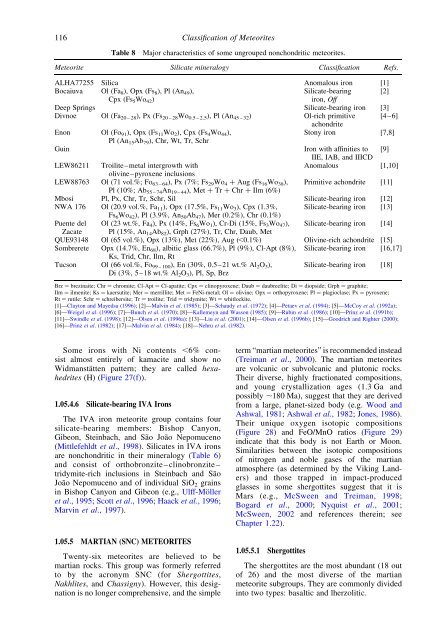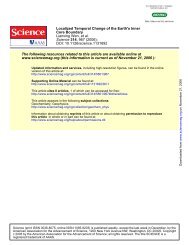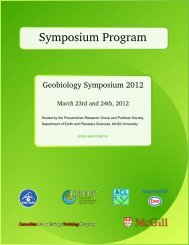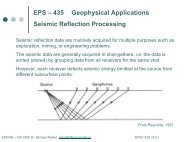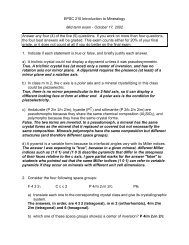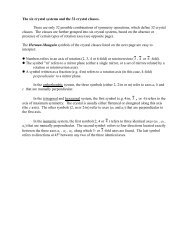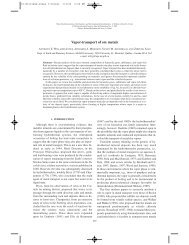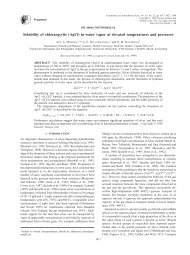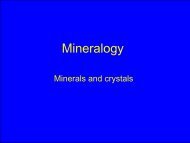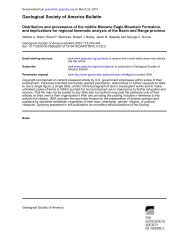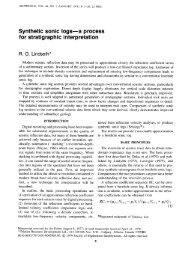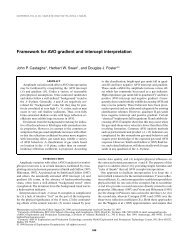05 Classification of.. - Department of Earth and Planetary Sciences
05 Classification of.. - Department of Earth and Planetary Sciences
05 Classification of.. - Department of Earth and Planetary Sciences
You also want an ePaper? Increase the reach of your titles
YUMPU automatically turns print PDFs into web optimized ePapers that Google loves.
116<br />
<strong>Classification</strong> <strong>of</strong> Meteorites<br />
Table 8<br />
Major characteristics <strong>of</strong> some ungrouped nonchondritic meteorites.<br />
Meteorite Silicate mineralogy <strong>Classification</strong> Refs.<br />
ALHA77255 Silica Anomalous iron [1]<br />
Bocaiuva Ol (Fa 8 ), Opx (Fs 8 ), Pl (An 49 ),<br />
Silicate-bearing [2]<br />
Cpx (Fs 5 Wo 42 )<br />
iron, Off<br />
Deep Springs Silicate-bearing iron [3]<br />
Divnoe Ol (Fa 20 – 28 ), Px (Fs 20 – 28 Wo 0.5 – 2.5 ), Pl (An 45 – 32 ) Ol-rich primitive [4–6]<br />
achondrite<br />
Enon Ol (Fo 91 ), Opx (Fs 11 Wo 2 ), Cpx (Fs 4 Wo 44 ),<br />
Stony iron [7,8]<br />
Pl (An 15 Ab 79 ), Chr, Wt, Tr, Schr<br />
Guin<br />
Iron with affinities to [9]<br />
IIE, IAB, <strong>and</strong> IIICD<br />
LEW86211 Troilite–metal intergrowth with<br />
Anomalous [1,10]<br />
olivine–pyroxene inclusions<br />
LEW88763 Ol (71 vol.%; Fo 63 – 64 ), Px (7%; Fs 29 Wo 4 þ Aug (Fs 16 Wo 38 ), Primitive achondrite [11]<br />
Pl (10%; Ab 55 – 74 An 19 – 44 ), Met þ Tr þ Chr þ Ilm (6%)<br />
Mbosi Pl, Px, Chr, Tr, Schr, Sil Silicate-bearing iron [12]<br />
NWA 176 Ol (20.9 vol.%, Fa 11 ), Opx (17.5%, Fs 11 Wo 3 ), Cpx (1.3%, Silicate-bearing iron [13]<br />
Fs 6 Wo 42 ), Pl (3.9%, An 50 Ab 47 ), Mer (0.2%), Chr (0.1%)<br />
Puente del Ol (23 wt.%, Fa 4 ), Px (14%, Fs 6 Wo 1 ), Cr-Di (15%, Fs 3 Wo 47 ), Silicate-bearing iron [14]<br />
Zacate Pl (15%, An 14 Ab 82 ), Grph (27%), Tr, Chr, Daub, Met<br />
QUE93148 Ol (65 vol.%), Opx (13%), Met (22%), Aug (,0.1%) Olivine-rich achondrite [15]<br />
Sombrerete Opx (14.7%, En 68 ), albitic glass (66.7%), Pl (9%), Cl-Apt (8%), Silicate-bearing iron [16,17]<br />
Ks, Trid, Chr, Ilm, Rt<br />
Tucson Ol (66 vol.%, Fo 99 – 100 ), En (30%, 0.5–21 wt.% Al 2 O 3 ),<br />
Di (3%, 5–18 wt.% Al 2 O 3 ), Pl, Sp, Brz<br />
Silicate-bearing iron [18]<br />
Brz ¼ brezinaite; Chr ¼ chromite; Cl-Apt ¼ Cl-apatite; Cpx ¼ clinopyroxene; Daub ¼ daubreelite; Di ¼ diopside; Grph ¼ graphite;<br />
Ilm ¼ ilmenite; Ks ¼ kaersutite; Mer ¼ merrillite; Met ¼ FeNi-metal; Ol ¼ olivine; Opx ¼ orthopyroxene; Pl ¼ plagioclase; Px ¼ pyroxene;<br />
Rt ¼ rutile; Schr ¼ schreibersite; Tr ¼ troilite; Trid ¼ tridymite; Wt ¼ whitlockite.<br />
[1]—Clayton <strong>and</strong> Mayedsa (1996); [2]—Malvin et al. (1985); [3]—Schaudy et al. (1972); [4]—Petaev et al. (1994); [5]—McCoy et al. (1992a);<br />
[6]—Weigel et al. (1996); [7]—Bunch et al. (1970); [8]—Kallemeyn <strong>and</strong> Wasson (1985); [9]—Rubin et al. (1986); [10]—Prinz et al. (1991b);<br />
[11]—Swindle et al. (1998); [12]—Olsen et al. (1996a); [13]—Liu et al. (2001); [14]—Olsen et al. (1996b); [15]—Goodrich <strong>and</strong> Righter (2000);<br />
[16]—Prinz et al. (1982); [17]—Malvin et al. (1984); [18]—Nehru et al. (1982).<br />
Some irons with Ni contents ,6% consist<br />
almost entirely <strong>of</strong> kamacite <strong>and</strong> show no<br />
Widmanstätten pattern; they are called hexahedrites<br />
(H) (Figure 27(f)).<br />
1.<strong>05</strong>.4.6 Silicate-bearing IVA Irons<br />
The IVA iron meteorite group contains four<br />
silicate-bearing members: Bishop Canyon,<br />
Gibeon, Steinbach, <strong>and</strong> São João Nepomuceno<br />
(Mittlefehldt et al., 1998). Silicates in IVA irons<br />
are nonchondritic in their mineralogy (Table 6)<br />
<strong>and</strong> consist <strong>of</strong> orthobronzite–clinobronzite–<br />
tridymite-rich inclusions in Steinbach <strong>and</strong> São<br />
João Nepomuceno <strong>and</strong> <strong>of</strong> individual SiO 2 grains<br />
in Bishop Canyon <strong>and</strong> Gibeon (e.g., Ulff-Möller<br />
et al., 1995; Scott et al., 1996; Haack et al., 1996;<br />
Marvin et al., 1997).<br />
1.<strong>05</strong>.5 MARTIAN (SNC) METEORITES<br />
Twenty-six meteorites are believed to be<br />
martian rocks. This group was formerly referred<br />
to by the acronym SNC (for Shergottites,<br />
Nakhlites, <strong>and</strong> Chassigny). However, this designation<br />
is no longer comprehensive, <strong>and</strong> the simple<br />
term “martian meteorites” is recommended instead<br />
(Treiman et al., 2000). The martian meteorites<br />
are volcanic or subvolcanic <strong>and</strong> plutonic rocks.<br />
Their diverse, highly fractionated compositions,<br />
<strong>and</strong> young crystallization ages (1.3 Ga <strong>and</strong><br />
possibly ,180 Ma), suggest that they are derived<br />
from a large, planet-sized body (e.g. Wood <strong>and</strong><br />
Ashwal, 1981; Ashwal et al., 1982; Jones, 1986).<br />
Their unique oxygen isotopic compositions<br />
(Figure 28) <strong>and</strong> FeO/MnO ratios (Figure 29)<br />
indicate that this body is not <strong>Earth</strong> or Moon.<br />
Similarities between the isotopic compositions<br />
<strong>of</strong> nitrogen <strong>and</strong> noble gases <strong>of</strong> the martian<br />
atmosphere (as determined by the Viking L<strong>and</strong>ers)<br />
<strong>and</strong> those trapped in impact-produced<br />
glasses in some shergottites suggest that it is<br />
Mars (e.g., McSween <strong>and</strong> Treiman, 1998;<br />
Bogard et al., 2000; Nyquist et al., 2001;<br />
McSween, 2002 <strong>and</strong> references therein; see<br />
Chapter 1.22).<br />
1.<strong>05</strong>.5.1 Shergottites<br />
The shergottites are the most abundant (18 out<br />
<strong>of</strong> 26) <strong>and</strong> the most diverse <strong>of</strong> the martian<br />
meteorite subgroups. They are commonly divided<br />
into two types: basaltic <strong>and</strong> lherzolitic.


